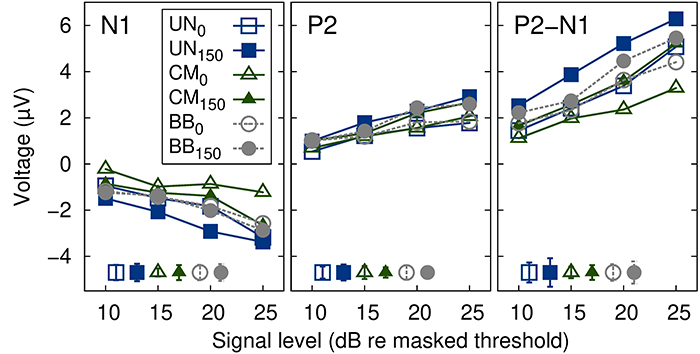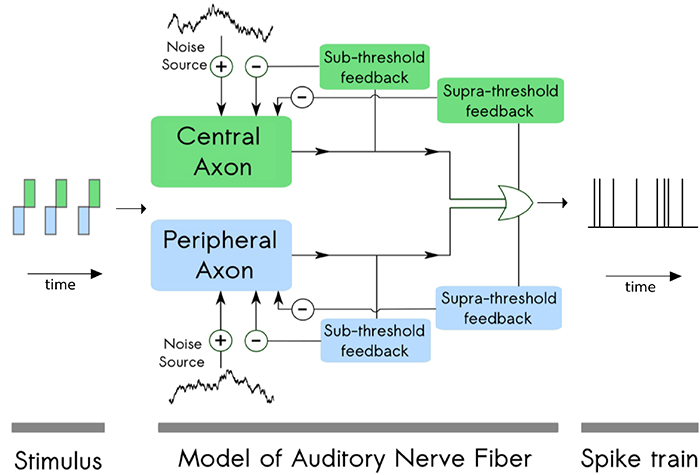Teaching in courses:
We are convinced that interdisciplinary work is the key to success. We work, collaborate and share knowledge across disciplines to solve the global challenges caused by hearing loss, affecting up to one billion people worldwide. Our focus lies on neurosensory systems to identify the physical and biological processes underlying information encoding and decoding in nature. The primary interest is the sense of hearing and, in particular, how acoustic information is processed and represented along the auditory pathway. To answer these questions, we use various methodologies to describe what we observe (physics and mathematics) and how information contained in sound is processed by humans (psychology, physiology). We learn from nature how to solve this task (neurobiology) and we try to mimic nature in quantitative models (engineering).
How is acoustical information encoded in the mechanical- and mechano-electrical transduction in the inner ear, the cochlea?
The inner ear of humans is a sophisticated acousto-hydro-electro-mechanical transduction device. It outperforms all current technical systems in terms of dynamic range, energy efficiency, and sensitivity.
We are convinced that nonlinear effects like synchronisation play a crucial role in the processing of sound. Numerical models help to identify these effects in hearing. We found that a nonlinear model solved in the time domain can account not only for physiological measures, but also links cochlear mechanics to basic psychoacoustical tasks. These models can also be used to investigate clustering effects due to entrainment and synchronization and to link them to both, otoacoustic emissions and perception. This approach questions current ideas about how the cochlea maps incoming sound onto a monotonic frequency-place map.

Figure 1: A chain of coupled, nonlinear oscillators driven by a sinusoidal force. If the oscillators were not connected, each would oscillate at its individual frequency. Coupling leads to organization of the oscillators into frequency plateaus. Driving all oscillators with a sinusoidal force will change these plateaus. We think that this phenomenon plays a key role in the processing of sound. [Sørensen et al. 2020]
It is not the cochlea that determines perception, but it provides the input into the neural system which shapes and encodes the relevant information that makes us hear. Regarding the cochlea as the biophysical system it is will help us to overcome current limitations set by oversimplifying its role to a simple filter bank.
Selected publications:
- Sørensen, L. M., Bysted, P. L., & Epp, B. (2020). Clustering in an array of nonlinear and active oscillators as a model of spontaneous otoacoustic emissions. In Proceedings of the "46. Jahrestagung der Akustik" (pp. 110-113).
[The thesis underlying this work received the student award of the German Acoustical Society in 2020] - Epp, B., Manley, G., & van Dijk, P. (2018). The mechanisms underlying multiple lobes in SOAE suppression tuning curves in a transmission line model of the cochlea. In To the Ear and Back Again - Advances in Auditory Biophysics [090005] American Institute of Physics. Aip Conference Proceedings, Vol.. 1965 https://doi.org/10.1063/1.5038494
- Verhey, J. L., Mauermann, M., & Epp, B. (2017). A Nonlinear Transmission Line Model of the Cochlea With Temporal Integration Accounts for Duration Effects in Threshold Fine Structure. Acta Acustica United With Acustica, 103(5), 721-724.
- Epp, B., Verhey, J. L., & Mauermann, M. (2010). Modeling cochlear dynamics: Interrelation between cochlea mechanics and psychoacoustics. Journal of the Acoustical Society of America, 128(4), 1870-1883.
How is acoustical information represented in the auditory brain and how does an impairment of the cochlea affect the neural representations along the auditory pathway?
Knowledge wise is the brain just as mystical as deep space. In cases of hearing impairment we observe deficits in perception that we can not yet compensate for technologically. And we can not yet build a device that matches the performance of the hearing system in separating simultaneously present sound sources. With non-invasive electrophysiological and numerical methods we investigate how sound information is represented in the neural representation of the brain. The cochlea plays a special role with it being the information bottleneck in hearing.
Basic effects like the representation of a signal masked by noise will provide us with essential information to describe the neural code of hearing and to utilize this to compensate for detrimental effects of hearing impairment.

Figure 2: Peak amplitudes of auditory evoked potentials measured on human listeners. We have shown that the neural response quantified by the P2 component is similar in different conditions, independent of the fact that the physical intensity differs by as much as 20 dB. [Egger et al. 2019]
Selected publications:
- Encina-Llamas, G., Harte, J., Dau, T., Shinn-Cunningham, B., & Epp, B. (2019). Investigating the Effect of Cochlear Synaptopathy on Envelope Following Responses Using a Model of the Auditory Nerve. J A R O, 20(4), 363-382. https://doi.org/10.1007/s10162-019-00721-7
Egger, K., Dau, T., & Epp, B. (2019). Supra-threshold perception and neural representation of tones presented in noise in conditions of masking release. PLOS ONE, 14(10), [e0222804]. https://doi.org/10.1371/journal.pone.0222804
- Bramhall, N., Beach, E. F., Epp, B., Le Prell, C. G., Lopez-Poveda, E. A., Plack, C. J., Schaette, R., Verhulst, S., & Canlon, B. (2019). The search for noise-induced cochlear synaptopathy in humans: Mission impossible? Hearing Research, 377, 88-103. https://doi.org/10.1016/j.heares.2019.02.016
How can the loss of mechanical- and mechano-electrical transduction in the cochlea be compensated for by using electrical stimulation in the auditory nerve?
Profound hearing loss can be compensated by a neuroprosthetic implant which bypasses the acousto-mechano-electrical transduction in the cochlea. Current pulses directly evoke activity in the sensory cells in the cochlea and thereby restore a sense of hearing. This is already a big step forward. But the performance of this technology declines greatly in the presence of noise. Fundamental differences in perception clearly show an activation of the sensory cells that does not benefit from the mechanisms of mechano-electrical transduction and only coarsely transduces usable sound information.

Figure 3: Point models that produce spikes provide a useful abstraction of the detailed dynamics of io chanelles controlling the dynamics of action potential generation. With such models, basic mechanisms of the electrically stimulated auditory nerve can be quantified. Especially the imp+act of pulse shape, pulse polarity and polarity interaction turned out to be key elements in understanding the response of the electrically stimulated auditory nerve and hence the limitations of current neuroprosthetic devices. [Joshi et al. 2017]
In collaboration with other colleagues we focus on the development of numerical models that help to predict the response of the sensory system to electrical stimulation. These models will also help to explain and eliminate detrimental effects caused by electrical stimulation in the conductive environment in the cochlea.
- Guérit, F., Marozeau, J., Epp, B., & Carlyon, R. P. (2020). Effect of the Relative Timing between Same-Polarity Pulses on Thresholds and Loudness in Cochlear Implant Users. JARO - Journal of the Association for Research in Otolaryngology, 21, 497–510. https://doi.org/10.1007/s10162-020-00767-y
- Guérit, F., Marozeau, J., Deeks, J. M., Epp, B., & Carlyon, R. P. (2018). Effects of the relative timing of opposite-polarity pulses on loudness for cochlear implant listeners. Journal of the Acoustical Society of America, 144(5), 2751-2763. https://doi.org/10.1121/1.5070150
- Joshi, S. N., Dau, T., & Epp, B. (2017). A Model of Electrically Stimulated Auditory Nerve Fiber Responses with Peripheral and Central Sites of Spike Generation. J A R O, 18(2), 323-342. https://doi.org/10.1007/s10162-016-0608-2
